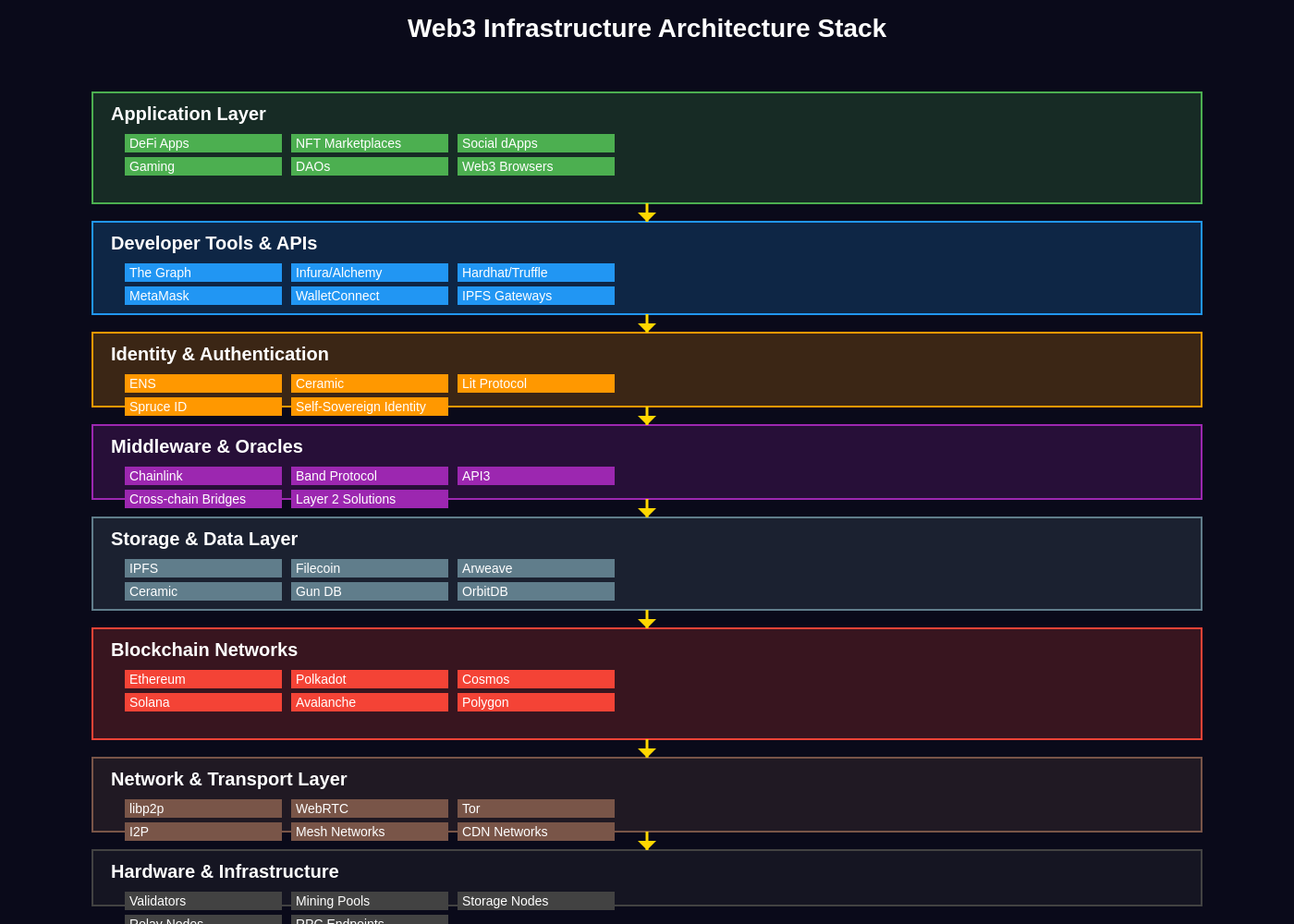
The Foundation of Digital Sovereignty
The internet as we know it today is fundamentally centralized, with massive corporations controlling data flows, user interactions, and digital value exchange. Web3 represents a paradigm shift toward a decentralized internet where users control their data, applications run on distributed networks, and value can be transferred without intermediaries. This transformation requires entirely new infrastructure built on blockchain technology, decentralized storage systems, and peer-to-peer networks that collectively form the backbone of the decentralized internet.
The centralized web has created unprecedented digital monopolies that extract value from users while maintaining complete control over their data and interactions. Tech giants like Google, Facebook, and Amazon have built walled gardens that trap users and developers within proprietary ecosystems, limiting innovation and creating single points of failure. Web3 infrastructure addresses these fundamental issues by distributing control across networks of participants, ensuring no single entity can dominate or censor the flow of information and value.
Blockchain Networks as the Computational Layer
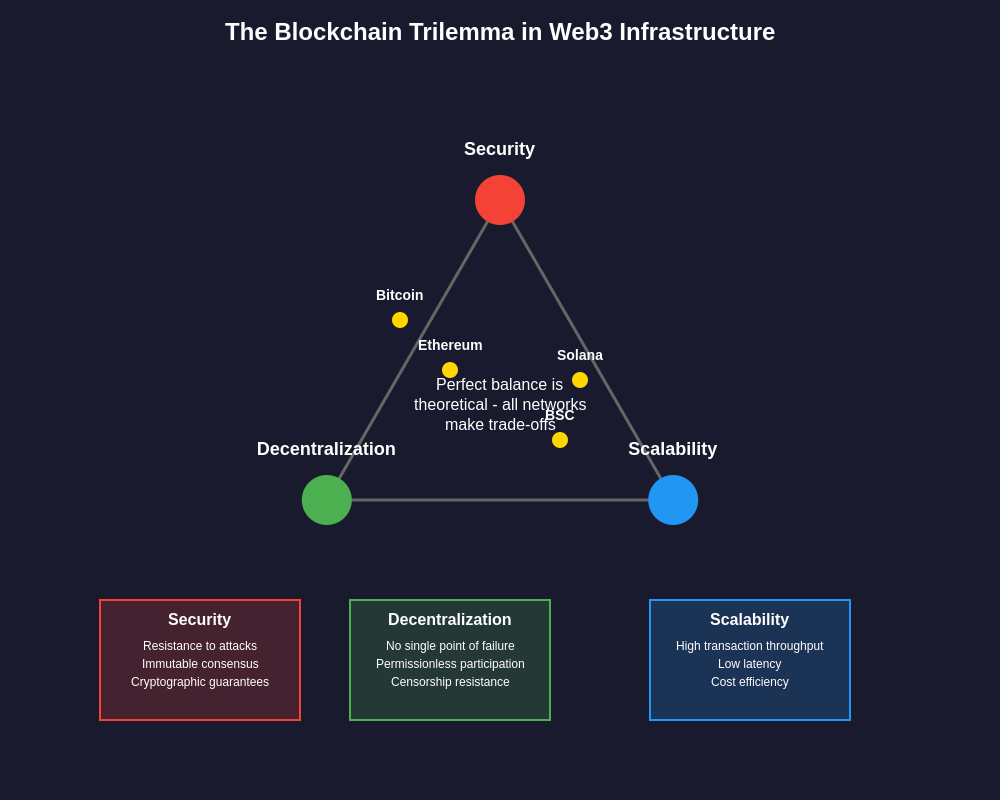
Blockchain networks serve as the computational foundation of Web3 infrastructure, providing decentralized execution environments where smart contracts can run without centralized control. Ethereum pioneered this concept with its virtual machine that enables developers to deploy arbitrary programs on a global, decentralized computer. However, the limitations of early blockchain networks, including high transaction costs and limited throughput, have driven innovation toward more scalable solutions that maintain decentralization principles while improving performance.
Layer 1 blockchain networks like Ethereum, Solana, and Avalanche each take different approaches to achieving scalability and decentralization. Ethereum’s transition to proof-of-stake consensus through Ethereum 2.0 significantly reduced energy consumption while maintaining security, but throughput remains limited by the base layer’s design constraints. Solana achieves higher throughput through innovations like proof-of-history consensus but faces trade-offs in decentralization and network stability. These architectural decisions reflect fundamental tension between scalability, security, and decentralization that defines blockchain trilemma challenges.
The emergence of application-specific blockchains represents another evolution in Web3 infrastructure, where developers can customize entire blockchain networks for specific use cases rather than building on general-purpose platforms. Cosmos and Polkadot enable this approach through their respective ecosystem architectures, allowing independent blockchains to communicate while maintaining sovereignty over their consensus mechanisms and governance structures. This modular approach to blockchain architecture provides flexibility that monolithic networks cannot match while enabling interoperability between different chains.
Layer 2 Scaling Solutions and Network Effects
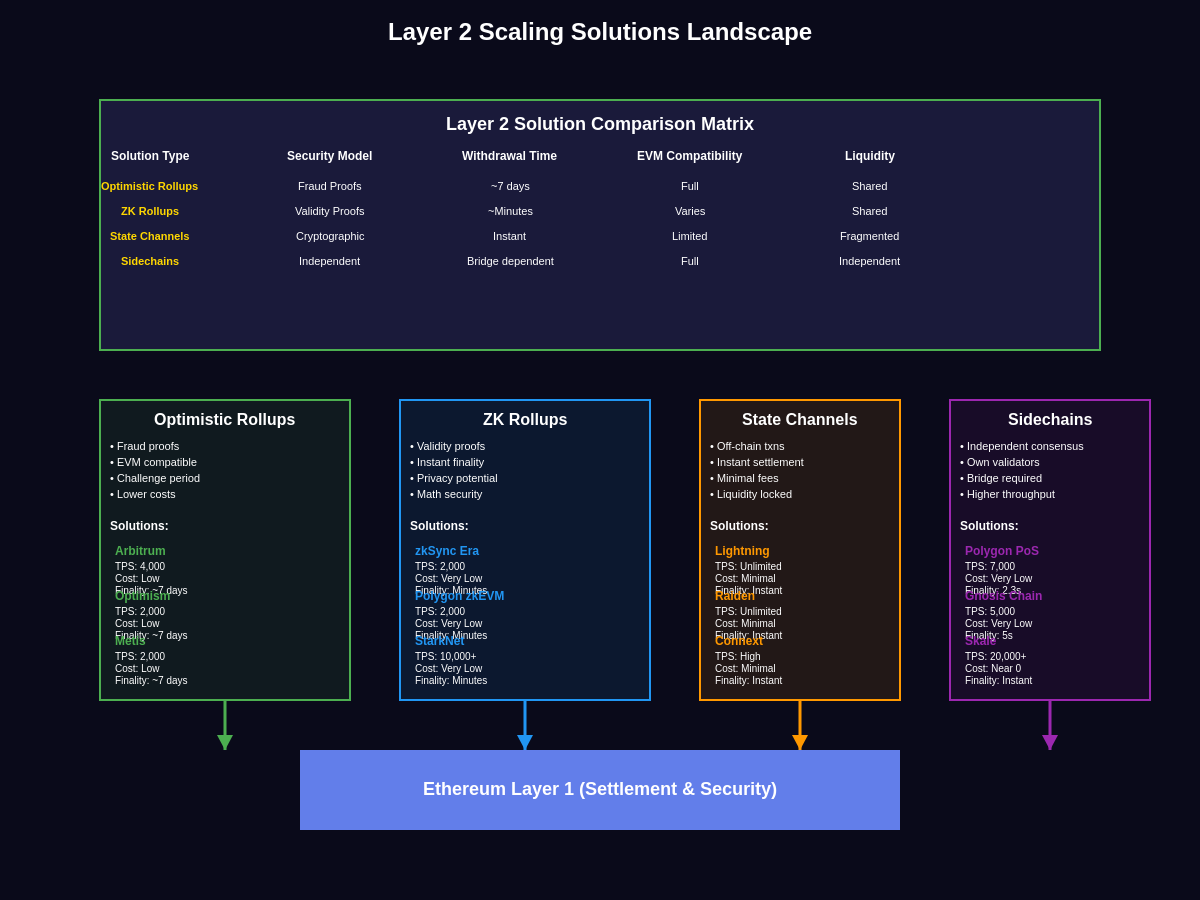
Layer 2 scaling solutions have become critical components of Web3 infrastructure by providing high-throughput execution environments that settle transactions on secure base layers. Optimistic rollups like Arbitrum and Optimism bundle thousands of transactions into single base layer commitments, dramatically reducing costs while inheriting the security properties of Ethereum. Zero-knowledge rollups take this concept further by providing cryptographic proofs of correct execution, enabling faster finality and potentially higher throughput than optimistic approaches.
The development of layer 2 ecosystems has created new network effects as applications and users migrate to these more cost-effective environments. Professional DeFi trading platforms and analytics tools enable users to track activity across multiple layer 2 networks, providing comprehensive views of liquidity and trading opportunities across the fragmented but interconnected Web3 landscape. This fragmentation presents both challenges and opportunities, as users must navigate multiple networks while developers can choose optimal execution environments for their specific applications.
State channels and payment channels represent another category of layer 2 solutions that enable instant, low-cost transactions between parties without requiring every transaction to be recorded on the base layer. Lightning Network for Bitcoin and state channels for Ethereum enable micropayments and high-frequency interactions that would be economically infeasible on base layers. These technologies are particularly important for enabling Web3 applications that require real-time interactions, such as gaming, streaming, and social media platforms.
Decentralized Storage and Data Availability
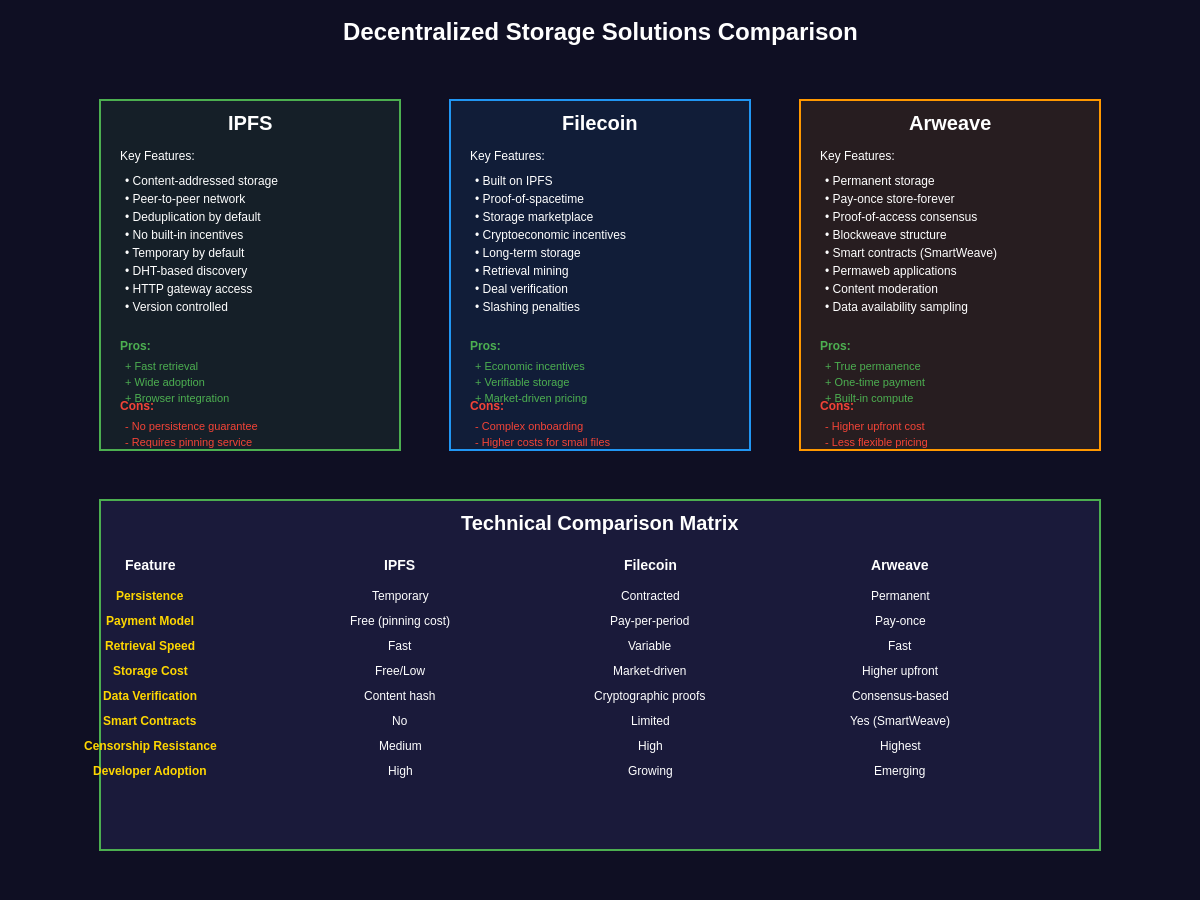
Traditional web applications rely on centralized servers and databases that create single points of failure and enable censorship by controlling entities. Web3 infrastructure requires decentralized storage solutions that can provide reliable, censorship-resistant data availability without relying on centralized providers. The InterPlanetary File System (IPFS) pioneered content-addressed storage where files are identified by their cryptographic hashes rather than location-based addresses, enabling global distribution and verification of data integrity.
Filecoin builds on IPFS by creating economic incentives for storage providers to maintain data availability over time, addressing the challenge of ensuring long-term persistence in decentralized storage networks. Storage providers stake tokens and provide cryptographic proofs of storage to earn rewards, creating a competitive marketplace for decentralized storage services. This model enables applications to store data reliably without depending on centralized cloud providers, though it requires different architectural approaches than traditional web development.
Arweave takes a different approach to permanent storage by using a novel consensus mechanism called proof-of-access that rewards miners for storing historical data. The network aims to provide permanent data storage with one-time payment fees, making it particularly suitable for archival use cases and NFT metadata storage. The economic model depends on deflationary tokenomics where storage costs decrease over time while the endowment of prepaid fees continues to incentivize ongoing storage provision.
Decentralized Identity and Authentication Systems
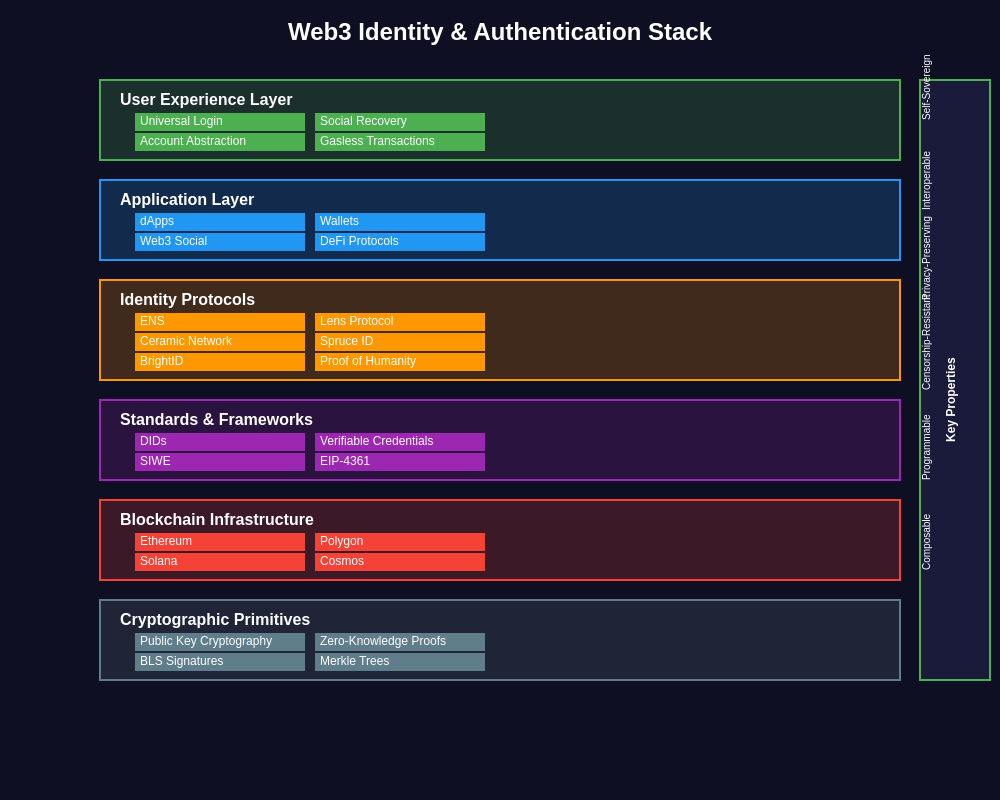
Web3 infrastructure requires new approaches to identity and authentication that don’t rely on centralized authorities or social media platforms for verification. Self-sovereign identity systems enable users to control their digital identities through cryptographic keys while selectively sharing verified credentials without revealing underlying personal information. This approach eliminates the need for countless username and password combinations while giving users complete control over their digital identity and reputation.
Ethereum Name Service (ENS) provides human-readable names for blockchain addresses while enabling users to associate various metadata with their identities, including social media profiles, website URLs, and avatar images. ENS demonstrates how decentralized naming systems can provide user-friendly experiences while maintaining the censorship resistance and ownership properties that define Web3 infrastructure. The system’s integration with wallets and applications shows how decentralized identity can become seamlessly integrated into user experiences.
Decentralized identifiers (DIDs) and verifiable credentials represent more comprehensive approaches to Web3 identity infrastructure, enabling users to prove various attributes about themselves without revealing unnecessary personal information. Educational institutions, employers, and other credential issuers can provide verifiable attestations that users can present selectively to applications and services. This zero-knowledge approach to identity verification enables rich user experiences while preserving privacy and eliminating the need for centralized identity providers.
Interoperability Protocols and Cross-Chain Infrastructure
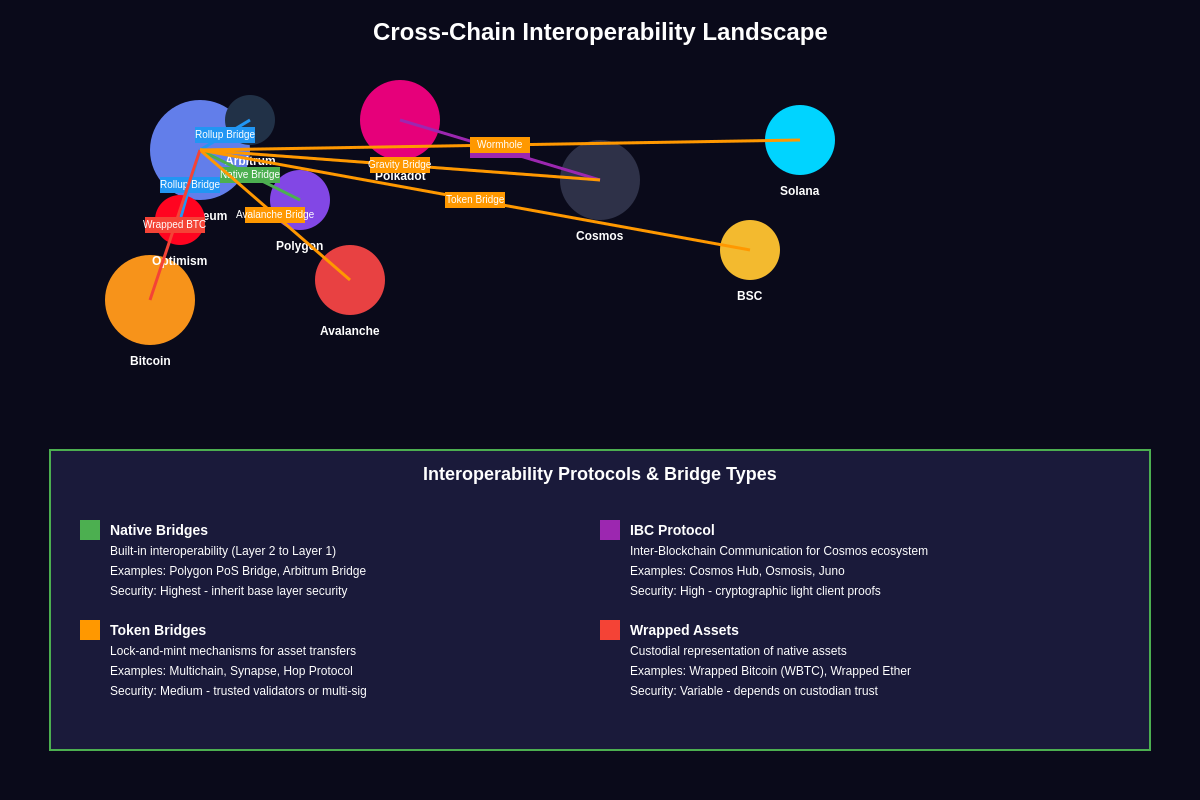
The multi-chain reality of Web3 requires robust interoperability solutions that enable assets and data to move seamlessly between different blockchain networks. Cross-chain bridges enable users to transfer tokens between networks, but they often require trust assumptions or centralized operators that create security risks and single points of failure. The frequency of bridge hacks and exploits demonstrates the challenges inherent in connecting networks with different security models and consensus mechanisms.
Inter-Blockchain Communication (IBC) protocol, developed by the Cosmos ecosystem, provides a more secure approach to cross-chain interoperability by enabling direct communication between chains that implement compatible interfaces. This approach eliminates the need for trusted intermediaries while enabling rich cross-chain functionality including token transfers, data sharing, and remote procedure calls. The protocol’s design shows how interoperability can be achieved without compromising the security properties of individual networks.
Polkadot’s approach to interoperability through its relay chain and parachain architecture enables different blockchains to share security while maintaining sovereignty over their execution environments. This shared security model reduces the cost and complexity of launching new blockchains while enabling seamless communication between chains in the ecosystem. Professional traders utilize advanced cross-chain analysis tools to monitor arbitrage opportunities and liquidity movements across different networks, highlighting the growing importance of interoperability in Web3 markets.
Decentralized Communication and Social Protocols
Web3 infrastructure extends beyond financial applications to include decentralized communication and social protocols that enable censorship-resistant social media, messaging, and content sharing. Traditional social media platforms control user data, content distribution algorithms, and monetization models, creating extractive relationships where platforms capture most of the value generated by user content and attention. Decentralized social protocols enable users to own their social graphs, content, and reputation while choosing how to monetize their digital presence.
The Lens Protocol demonstrates how social media functionality can be implemented as composable smart contracts that enable different applications to build on shared social data. Users own their profiles as NFTs and can port their followers, content, and reputation between different applications built on the protocol. This composability enables rapid innovation in social media experiences while ensuring users retain control over their digital identity and social connections.
Matrix protocol provides decentralized messaging infrastructure that enables secure, end-to-end encrypted communication without relying on centralized servers. The protocol’s federated architecture allows different servers to interoperate while users maintain control over their communication history and contacts. Integration with Web3 identity systems enables users to associate their Matrix identities with their blockchain addresses, creating unified digital identities that span communication and financial applications.
Developer Tools and Infrastructure Platforms
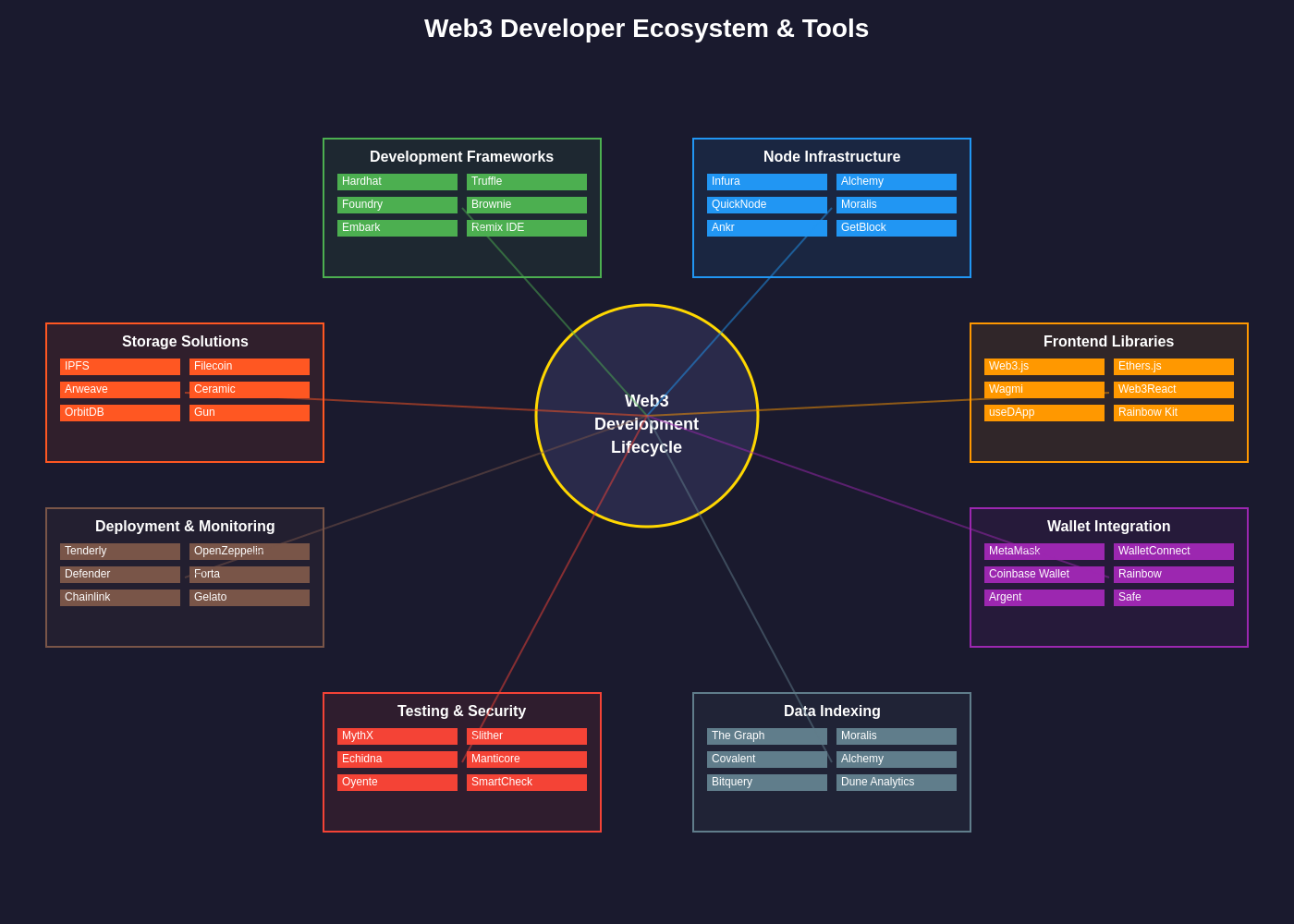
Building applications on Web3 infrastructure requires specialized development tools that abstract away the complexity of blockchain interactions while providing access to decentralized services. Infura and Alchemy provide managed blockchain node infrastructure that enables developers to interact with Ethereum and other networks without running their own nodes, though this introduces centralization risks that some projects are working to address through decentralized alternatives.
The Graph protocol enables developers to index and query blockchain data efficiently, providing GraphQL APIs for accessing on-chain information without requiring complex blockchain interaction code. Subgraphs define how to extract and transform blockchain data into queryable formats, enabling applications to provide rich user experiences based on on-chain activity. This infrastructure is critical for applications that need to display historical data, user balances, and transaction histories in real-time user interfaces.
Web3 development frameworks like Hardhat, Truffle, and Foundry provide testing environments, deployment tools, and debugging capabilities specifically designed for smart contract development. These tools handle the complexity of compiling, testing, and deploying smart contracts while providing integration with popular JavaScript and TypeScript development workflows. The maturation of these development tools has significantly reduced the barriers to entry for Web3 application development.
Economic Models and Token Incentive Structures
Web3 infrastructure relies on token-based economic models that align incentives between network participants while providing sustainable funding for ongoing operations and development. Unlike traditional web infrastructure that depends on advertising revenue or subscription fees, Web3 networks can use native tokens to directly compensate participants who provide computational resources, storage, bandwidth, or other valuable services to the network.
Staking mechanisms enable token holders to participate in network consensus while earning rewards for securing the network, creating economic incentives for long-term commitment to network health. Validators who violate consensus rules face slashing penalties that reduce their staked tokens, creating strong disincentives for malicious behavior. This cryptoeconomic security model enables networks to maintain Byzantine fault tolerance without relying on trusted authorities or legal frameworks.
Token distribution mechanisms play crucial roles in bootstrapping network effects and ensuring fair participation in Web3 infrastructure. Airdrops to early users and developers can kickstart adoption while rewarding community members who contribute to network growth. However, token distribution strategies must balance fairness concerns with the need to attract sufficient capital and talent to build robust infrastructure that can compete with centralized alternatives.
Governance and Network Evolution Mechanisms
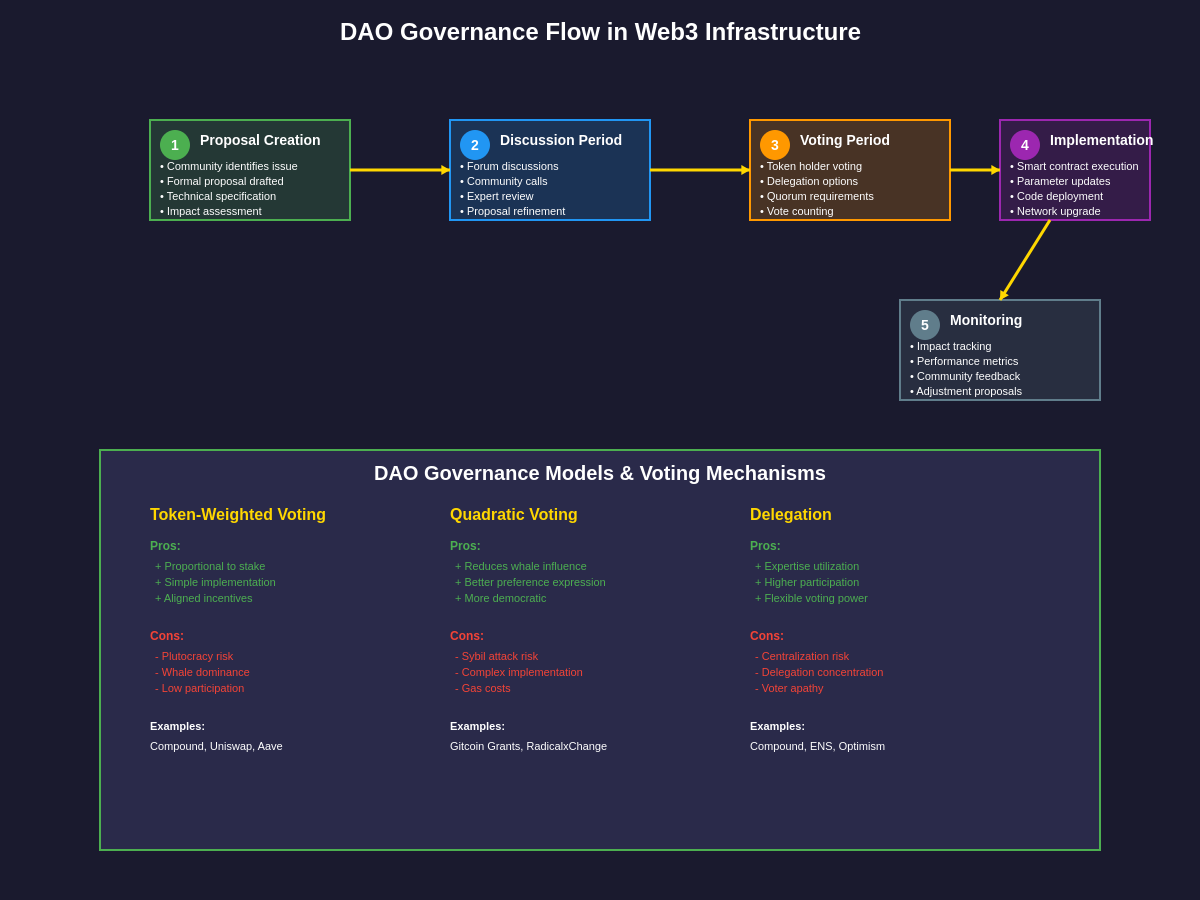
Web3 infrastructure requires governance mechanisms that enable networks to evolve and adapt to changing requirements while maintaining decentralization and avoiding capture by special interests. On-chain governance systems enable token holders to propose and vote on protocol upgrades, parameter changes, and resource allocation decisions. However, token-based voting can lead to plutocracy where wealthy participants have disproportionate influence over network direction.
Quadratic voting and other alternative governance mechanisms attempt to balance the influence of different stakeholders while maintaining resistance to sybil attacks and collusion. Gitcoin Grants uses quadratic funding to allocate resources to public goods projects, demonstrating how innovative governance mechanisms can direct resources toward activities that benefit the broader ecosystem rather than individual profit maximization.
Futarchy and prediction market governance represent experimental approaches that attempt to separate decisions about network values from predictions about which policies will achieve those values. These mechanisms enable communities to define their objectives clearly while leveraging market mechanisms to identify the most effective strategies for achieving those goals. While still largely theoretical, these governance innovations could enable more effective coordination in large, diverse communities.
Privacy and Security Infrastructure
Web3 infrastructure must provide robust privacy and security guarantees that protect users from surveillance, censorship, and financial exploitation while enabling rich application functionality. Zero-knowledge proof systems enable applications to verify computations without revealing underlying data, opening possibilities for private DeFi, anonymous voting, and confidential smart contracts that preserve user privacy while maintaining network security.
Tornado Cash demonstrated both the potential and the challenges of privacy infrastructure in Web3, providing users with transaction privacy through zero-knowledge proofs while facing regulatory pressure due to its use in money laundering activities. The tension between privacy rights and regulatory compliance highlights fundamental challenges in building privacy infrastructure that can operate within existing legal frameworks while providing meaningful protection for legitimate users.
Secure multi-party computation (MPC) and threshold cryptography enable groups of participants to jointly compute functions over private inputs without revealing those inputs to each other. These technologies enable new models of key management, private auctions, and confidential data sharing that could be critical for enterprise adoption of Web3 infrastructure. The complexity of implementing these systems securely requires significant expertise and careful security auditing.
Performance Optimization and User Experience
Web3 infrastructure faces significant challenges in providing user experiences that compete with centralized web applications while maintaining decentralization properties. Transaction latency, confirmation times, and gas fee volatility create friction that can drive users back to familiar centralized alternatives. Account abstraction technologies attempt to address these issues by enabling more flexible transaction models that can batch operations, pay fees in different tokens, and provide social recovery mechanisms.
Meta-transactions and gasless transaction models enable applications to subsidize transaction costs for users, providing experiences similar to traditional web applications where users don’t need to manage blockchain tokens or understand gas mechanics. These approaches require careful economic design to prevent abuse while providing sustainable funding for transaction costs. Some networks experiment with fee structures and tokenomics that make transaction costs more predictable for both users and application developers.
Progressive decentralization strategies enable applications to start with more centralized architectures that provide familiar user experiences while gradually transitioning control to decentralized governance and infrastructure. This approach allows teams to iterate on user experience and product-market fit before committing to fully decentralized architectures that may be more difficult to modify. However, these strategies require clear timelines and credible commitments to avoid indefinite centralization.
Enterprise Adoption and Institutional Infrastructure
Large enterprises and institutions require Web3 infrastructure that can meet their compliance, security, and performance requirements while providing clear legal frameworks and regulatory certainty. Enterprise blockchain platforms like Hyperledger Fabric and R3 Corda provide permissioned network architectures that enable institutions to collaborate while maintaining control over participant access and data privacy.
Custody solutions for institutional participants require robust security measures, insurance coverage, and regulatory compliance that meet fiduciary standards for managing client assets. Qualified custodians like Coinbase Custody and Fidelity Digital Assets provide institutional-grade security while enabling participation in DeFi protocols and other Web3 applications through carefully designed risk management frameworks.
Central bank digital currencies (CBDCs) represent another pathway for institutional adoption of Web3 infrastructure, though their design often prioritizes government control over the privacy and censorship resistance properties that define decentralized systems. The coexistence of CBDCs with decentralized cryptocurrencies will likely create complex regulatory environments that shape how Web3 infrastructure evolves to serve both individual users and institutional participants.
Environmental Sustainability and Energy Efficiency
The environmental impact of blockchain infrastructure has become a critical consideration as Web3 systems scale to serve global user bases. Proof-of-work consensus mechanisms like those used by Bitcoin require significant energy consumption to maintain security, though much of this energy comes from renewable sources and helps stabilize electrical grids by providing flexible demand. Proof-of-stake systems like Ethereum 2.0 achieve similar security properties with drastically reduced energy consumption.
Carbon offset programs and renewable energy adoption among blockchain infrastructure providers demonstrate industry awareness of environmental concerns while highlighting the potential for Web3 systems to incentivize clean energy adoption. Some projects explicitly integrate carbon credit trading and environmental monitoring into their core protocols, using blockchain infrastructure to create more transparent and efficient markets for environmental goods.
The energy efficiency of different consensus mechanisms continues to evolve as new approaches like proof-of-space-time and proof-of-useful-work attempt to provide security while directing computational resources toward socially valuable activities. These innovations could enable Web3 infrastructure to provide positive environmental externalities while maintaining the security and decentralization properties that define these systems.
Regulatory Frameworks and Compliance Infrastructure
Web3 infrastructure operates in a complex and evolving regulatory environment where different jurisdictions take varied approaches to cryptocurrency regulation, data privacy, and financial services oversight. The European Union’s Markets in Crypto-Assets (MiCA) regulation provides comprehensive framework for cryptocurrency operations while the United States continues to develop regulatory clarity through enforcement actions and proposed legislation.
Know Your Customer (KYC) and Anti-Money Laundering (AML) compliance requirements create tension with the privacy and pseudonymity properties that many users value in Web3 systems. Privacy-preserving compliance solutions attempt to satisfy regulatory requirements while minimizing data collection and enabling selective disclosure of information only when required by law enforcement or regulatory authorities.
Decentralized Autonomous Organizations (DAOs) face particular regulatory uncertainty as they don’t fit neatly into existing legal categories for business entities. Some jurisdictions like Wyoming have created specific legal frameworks for DAOs while others apply existing partnership or corporate laws that may not be well-suited to decentralized governance structures. This regulatory uncertainty affects how Web3 infrastructure can be used for various applications and business models.
The Future of Decentralized Internet Architecture
The evolution toward a fully decentralized internet requires continued innovation in infrastructure that can provide the performance, usability, and functionality that users expect from digital applications while maintaining the sovereignty and censorship resistance that define Web3 systems. Emerging technologies like verifiable computation, homomorphic encryption, and quantum-resistant cryptography will likely play important roles in future infrastructure architectures.
The integration of artificial intelligence and machine learning with Web3 infrastructure creates opportunities for new applications and services while raising questions about data ownership, algorithmic bias, and decision-making transparency. Decentralized AI training and inference systems could enable innovation while preserving user privacy and preventing concentration of AI capabilities among a few large corporations.
As Web3 infrastructure matures, the distinction between centralized and decentralized web may become less apparent to end users who simply want applications that work reliably and provide value. The success of Web3 infrastructure will ultimately be measured by its ability to enable innovation, protect user rights, and create economic opportunities while providing experiences that compete with the best centralized alternatives. The ongoing development of this infrastructure represents one of the most significant technological shifts since the creation of the internet itself, with implications that extend far beyond the cryptocurrency industry into fundamental questions about digital sovereignty, economic freedom, and technological governance.
Professional infrastructure monitoring and analysis tools enable developers and investors to track the growth and adoption of various Web3 infrastructure components, providing insights into which technologies are gaining traction and where future development efforts might be most impactful for building the decentralized internet of tomorrow.
Disclaimer: This article is for educational and informational purposes only and should not be construed as financial advice. Web3 technologies and cryptocurrency investments carry significant risks, including the potential for total loss of capital. The regulatory environment for Web3 infrastructure continues to evolve and may impact the viability of various technologies and applications. Always conduct your own research and consult with qualified advisors before making investment decisions or implementing Web3 technologies. The author and publisher are not responsible for any financial losses that may occur from acting on the information provided in this article.